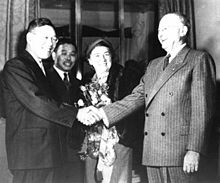This article needs additional citations for verification. (February 2015) |
The Dodge Line or Dodge Plan was a financial and monetary contraction policy drafted by American economist Joseph Dodge for Japan to gain economic independence and stamp out inflation after World War II.[1] It was announced on March 7, 1949. The Dodge Line was a major element of the so-called Reverse Course—a broader shift in the policies of the U.S.-led military occupation of Japan from an initial phase of demilitarizing and democratizing Japan to remilitarizing and economically strengthening Japan in response to rising Cold War tensions in East Asia.

Background
editOn September 2, 1945, Japan surrendered to the Allied powers, bringing an end to World War II in Asia, and leading to the U.S.-led Allied Occupation of Japan. In the initial phases, the Occupation focused on liberalizing and democratizing Japanese society to ensure that Japan would never again be a threat to world peace.[2] Within this permissive atmosphere, the Occupation allowed the Japanese to pursue an expansionary economic policy, but the economy quickly overheated, leading to hyperinflation.[3] From September 1945 to August 1948, prices in Japan increased more than 700%, which precipitated major unrest across broad sectors of Japanese society.[3]
Meanwhile, Cold War tensions were ramping up in Europe, where the Soviet occupation of Eastern European countries led Winston Churchill to give his 1946 "Iron Curtain" speech, as well as in Asia, where the tide was turning in favor of the Communists in the Chinese Civil War.[4] These shifts in the geo-political environment led to a profound shift in U.S. government and Allied Occupation thinking about Japan, and rather than focusing on punishing and weakening Japan for its wartime transgressions, the focus shifted to rebuilding and strengthening Japan as a potential ally in the emerging global Cold War. Meanwhile on the Japanese domestic front, rampant inflation, food insecurity, and widespread poverty in the wake of Japan's defeat fostered the rapid expansion of militant leftist political parties and labor unions, leading Occupation authorities to fear that Japan was ripe for communist exploitation or even a communist revolution.
Dodge's plan
editIn order to address the twin goals of strengthening Japan economically and disempowering the Japanese left by taming inflation, the Occupation brought in Detroit banker Joseph Dodge as an economic policy consultant. In February 1949, Dodge arrived in Japan to take stock of the situation, and on March 7, he announced his plan, known as the "Dodge Line." It recommended:
- Balancing the national budget to reduce inflation
- More efficient tax collection
- Dissolving the Reconstruction Finance Bank because of its uneconomical loans
- Decreasing the scope of government intervention
- Fixing the exchange rate to 360 yen to one US dollar to keep Japanese export prices low
Effects
editThese policies succeeded in getting Japan's rampant inflation under control, but caused significant short-term hardship for Japanese workers, leading to mass layoffs as the economy went into contraction, a painful period of economic adjustment known as the "Dodge squeeze."[5] Japan was plunged into a severe recession (ja:安定恐慌), which did not end until the massive economic stimulus produced by U.S. military special procurements in Japan following the outbreak of the Korean War in 1950.[6]
The fixed exchange rate of 360 yen to one dollar remained unchanged into the early 1970s, helping turbo-charge Japanese exports and fueling the Japanese economic miracle.
Economic indicators and timeline
edit| Year | GNP Growth Rate (%) | Inflation Rate (%) | Monetary Base Growth Rate (%) | Gov's Debt Growth Rate (%) | Trade balance to GNP Ratio (%) | Major Events |
|---|---|---|---|---|---|---|
| 1945 | — | 51.1 | 148.2 | 9.0 | — | Surrender of Japan (Aug.) |
| 1946 | — | 364.5 | 67.6 | 418.3 | — | Financial asset freeze (Feb.); zaibatsu dissolution |
| 1947 | 8.4 | 195.9 | 132.9 | 75.9 | -6.2 | General strikes banned (Feb.); break up of monopolies, land reform, labor reform |
| 1948 | 13.0 | 165.5 | 61.5 | 135.1 | -3.8 | |
| 1949 | 2.2 | 63.3 | 0.3 | 56.0 | -2.0 | Dodge Plan (Feb.); Unification of multiple exchange rates to 360 yen per dollar (April); National Railway president Death (July) |
| 1950 | 11.0 | 18.2 | 18.9 | 1.2 | 0.3 | Korean war started (June) |
| 1951 | 13.0 | 38.8 | 19.9 | 24.0 | -1.9 | Treaty of San Francisco
Korea War armistice talk started |
| 1952 | 11.0 | 2.0 | 13.8 | 16.8 | -2.3 | |
| 1953 | 5.7 | 5.0 | 10.8 | 16.6 | -4.5 | Korean War armistice signed (July) |
| 1954 | 6.1 | 6.5 | -0.9 | 2.3 | -2.2 |
References
editCitations
edit- ^ Savage, J.D. (2002-06-01). "The Origins of Budgetary Preferences: The Dodge Line and the Balanced Budget Norm in Japan" (PDF). Administration & Society. doi:10.1177/009539902400387191. S2CID 154384324.
- ^ Kapur 2018, p. 8.
- ^ a b Sugita 2021, p. 8.
- ^ Kapur 2018, p. 9.
- ^ Takemae 2002, p. 470.
- ^ Ito, Takatoshi; Hoshi, Takeo (2019). The Japanese economy Second Edition. The MIT Press. p. 93. ISBN 9780262538244.
- ^ Toyo Keizai. 1979.
Sources cited
edit- Kapur, Nick (2018). Japan at the Crossroads: Conflict and Compromise after Anpo. Cambridge, MA: Harvard University Press. ISBN 978-0674984424.
- Sugita, Yoneyuki (11 May 2021). "A Paradox: the Red Purge Has Made Japan a Law-Abiding Nation". East Asia. 38 (4): 353–371. doi:10.1007/s12140-021-09365-y. ISSN 1096-6838. S2CID 236582291. Retrieved 8 July 2021.
- Takemae, Eiji (2002). Inside GHQ : the Allied occupation of Japan and its legacy. New York: Continuum. ISBN 9780826462466. Retrieved 16 August 2021.